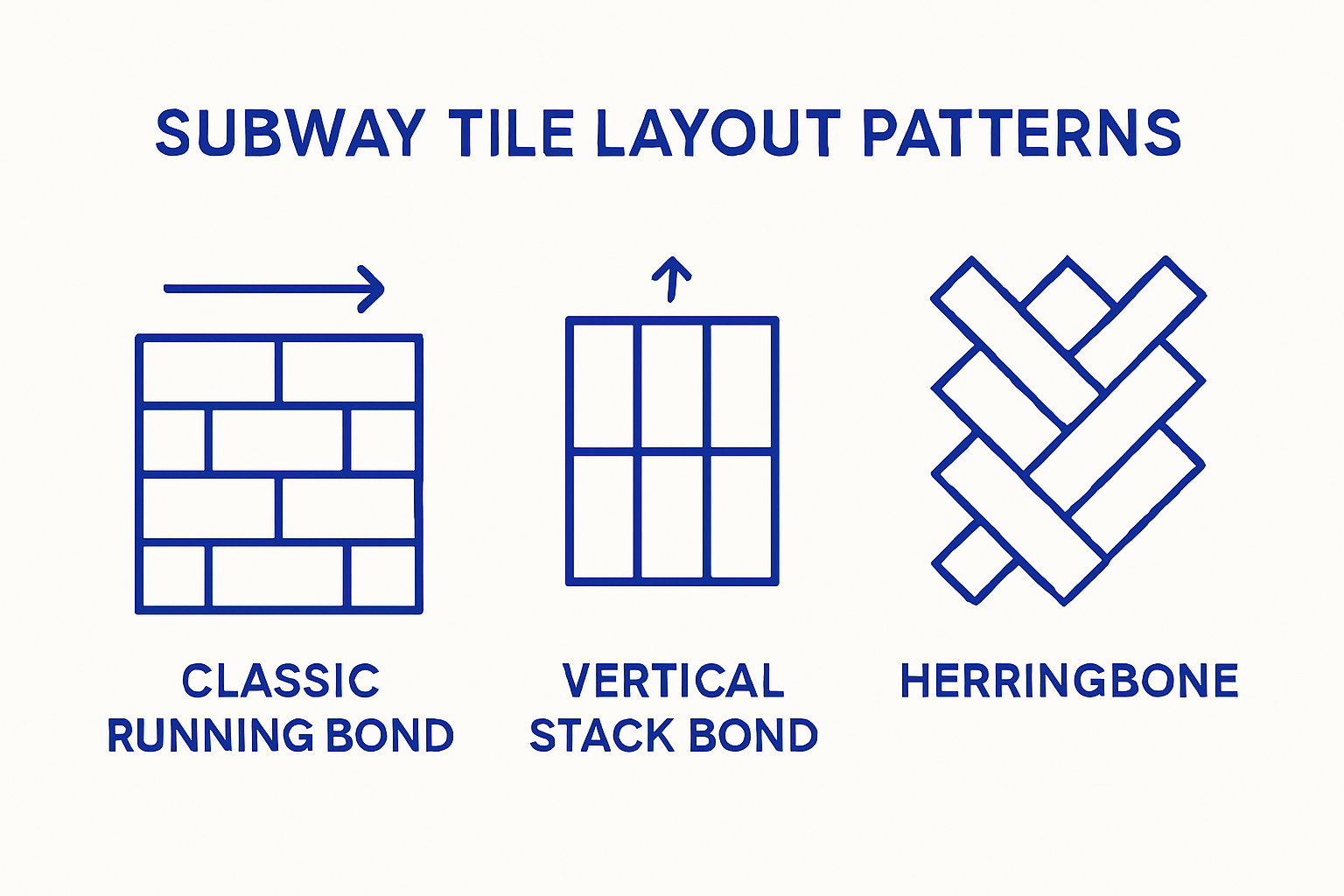What is Subway Tile Pattern: Understanding Its Appeal
Posted by Mike Belk on Oct 02, 2025

Subway tile patterns have shaped kitchens and bathrooms for over a century. These instantly recognizable rectangular tiles first hit the New York City subway system in 1904 and became a global design staple. But most people are surprised to learn just how flexible subway tiles have become. The original 3 by 6 inch format set the stage but now you will find dozens of creative arrangements beyond the classic horizontal layout. Designers are even using colors and shapes that break every old rule.
Table of Contents
- Defining Subway Tile Patterns: What Are They?
- Historical Significance of Subway Tile Patterns
- Popular Designs and Variations of Subway Tile Patterns
- Applications in Home and Commercial Spaces
- Choosing the Right Subway Tile Pattern for Your Project
Quick Summary
| Takeaway | Explanation |
|---|---|
| Subway tiles originated in early 1900s NYC. | The design emerged during subway station construction, prioritizing elegance and durability. |
| Classic horizontal layout remains popular. | The traditional running bond pattern features staggered tiles, enhancing visual interest and versatility. |
| Varied installation patterns enhance design flexibility. | Different arrangements, like herringbone or vertical stacking, provide unique aesthetics and spatial impressions. |
| Subway tiles suit residential and commercial spaces. | Their practicality and aesthetic appeal make them ideal for kitchens, bathrooms, and public spaces. |
| Choose patterns based on room size and style. | Evaluating a room’s dimensions and existing decor helps in selecting the most suitable subway tile configuration. |
Defining Subway Tile Patterns: What Are They?
A subway tile pattern represents a classic rectangular ceramic tile traditionally measuring 3 inches by 6 inches, characterized by its simple yet elegant horizontal layout with offset joints. This iconic design originated in the early 1900s during the construction of New York City subway stations, where its clean aesthetic and practical durability quickly captured public imagination.
The Classic Horizontal Arrangement
In its most traditional form, subway tiles are installed in a classic running bond pattern, where each row of tiles is offset by half a tile’s width. This creates a staggered, brick-like appearance that delivers visual interest while maintaining a streamlined look. Designers appreciate this pattern because it provides a timeless backdrop that complements various architectural styles, from vintage to contemporary spaces. Our ultimate guide to subway tiles offers more insights into these versatile design elements.
Variations and Modern Interpretations
While the original subway tile configuration remains popular, contemporary design has expanded its potential dramatically. Modern interpretations include vertical installations, herringbone patterns, vertical stack bonds, and diagonal arrangements. These variations allow homeowners and designers to transform a traditional concept into a personalized design statement. Each configuration offers a unique visual texture and can dramatically alter a space’s perceived dimensions and aesthetic character.
To help readers compare different popular layouts mentioned in the article, the following table highlights key characteristics and the visual effects of each subway tile pattern.
| Pattern Name | Arrangement Description | Visual Effect |
|---|---|---|
| Classic Running Bond | Rows offset by half tile width horizontally | Timeless, adds width, balanced |
| Vertical Stack Bond | Tiles stacked directly above one another | Clean, modern, emphasizes height |
| Herringbone | Tiles laid at 45-degree angles in a zigzag | Dynamic, creates movement |
| Vertical Running Bond | Rows offset vertically by half tile height | Unconventional, height-focused |
| Diagonal Arrangement | Tiles set diagonally across the surface | Adds dramatic, creative energy |
Key characteristics of subway tile patterns include:
- Rectangular shape with standard 3x6 inch dimensions
- Typically made from ceramic or porcelain materials
- Versatile installation options with multiple pattern possibilities
- Easy to clean and maintain surfaces
- Ability to complement various design aesthetics
According to architectural design research, subway tiles have transcended their original utilitarian purpose to become a design staple in kitchens, bathrooms, and commercial spaces worldwide, demonstrating remarkable design adaptability.
Historical Significance of Subway Tile Patterns
Subway tiles emerged as more than just a decorative element during the early 20th century, representing a profound intersection of urban design, public health, and architectural innovation. Their origin story is deeply rooted in the transformation of New York City’s underground transportation infrastructure, where functionality and aesthetic clarity converged to create an enduring design language.
Urban Infrastructure and Public Health
In the early 1900s, subway tiles were strategically selected for their remarkable durability and hygienic properties. What is subway tile? reveals how these ceramic tiles became critical in creating clean, easily maintainable surfaces in public spaces. The white glazed ceramic tiles reflected light, made dirt and grime visibly apparent, and could be swiftly cleaned, addressing critical public health concerns of the era. Architects and city planners recognized these tiles as more than mere surface coverings they were instrumental in promoting urban cleanliness and preventing the spread of infectious diseases.
Architectural and Design Evolution
The subway tile’s design philosophy transcended its original utilitarian purpose, becoming a symbol of modernist design principles. According to historical architectural research, these tiles embodied the early 20th-century ideals of simplicity, functionality, and geometric precision. Their standardized rectangular shape and modular nature represented a design approach that prioritized efficiency and reproducibility, principles that would later influence numerous architectural and design movements.
Key historical milestones of subway tiles include:
- Introduction in New York City subway stations around 1904
- Rapid adoption in public buildings and residential spaces
- Symbolization of urban modernization and cleanliness
- Representation of early industrial design principles
- Global spread as a versatile architectural material
The legacy of subway tiles extends far beyond their original context, transforming from a purely functional infrastructure element to a timeless design feature that continues to inspire architects and designers worldwide. Their journey reflects broader narratives of urban development, technological innovation, and aesthetic evolution.
Popular Designs and Variations of Subway Tile Patterns
Subway tile patterns have dramatically evolved from their original horizontal configuration, offering designers and homeowners an expansive palette of creative possibilities. These variations transform the classic rectangular tile into a dynamic design element that can dramatically alter a space’s visual character and aesthetic appeal.
Classic and Contemporary Layouts
The traditional horizontal offset pattern remains a foundational design, but contemporary interpretations have pushed boundaries significantly. Modern subway tile arrangements include vertical stacking, which creates a sleek, minimalist appearance, and herringbone configurations that introduce dynamic angular movement.
 Unique and stylish ways to use subway tile showcase how these layouts can dramatically transform interior spaces.
Unique and stylish ways to use subway tile showcase how these layouts can dramatically transform interior spaces.
Color and Material Innovations
Beyond geometric arrangements, subway tiles now come in an extraordinary range of colors, materials, and finishes. Designers are no longer restricted to the classic white ceramic tile. Contemporary options include:
- Glossy and matte ceramic tiles
- Handmade artisan tiles with subtle color variations
- Metallic and iridescent glazed finishes
- Natural stone and marble-look ceramic tiles
- Textured and three-dimensional tile surfaces
According to interior design trends, these material and color innovations allow subway tiles to adapt to virtually any design aesthetic, from industrial loft spaces to elegant traditional interiors. The versatility of subway tiles enables them to serve as both subtle background elements and bold design statements.
The ongoing evolution of subway tile patterns demonstrates their remarkable design flexibility. Each variation offers unique visual texture, spatial perception, and design potential, proving that these classic tiles continue to be a dynamic and adaptable design solution for contemporary spaces.

Applications in Home and Commercial Spaces
Subway tiles have transcended their original architectural origins to become a versatile design solution across diverse residential and commercial environments. Their adaptability, durability, and aesthetic flexibility make them an ideal choice for spaces requiring both functional performance and visual appeal.
Residential Design Applications
In residential settings, subway tiles serve multiple purposes beyond mere wall coverings. Kitchens and bathrooms represent primary domains where these tiles shine, offering easy maintenance and design versatility. Backsplashes, shower walls, and kitchen accent areas benefit from subway tiles’ clean lines and ability to create visual continuity. Bathroom ceramic subway tiles demonstrate how these tiles can transform ordinary spaces into elegant, functional environments.
Commercial and Institutional Spaces
Commercial applications of subway tiles extend far beyond aesthetic considerations. According to medical infrastructure research, these tiles play a critical role in maintaining hygienic environments in healthcare facilities, restaurants, and public buildings. Their non-porous surfaces and ease of cleaning make them an excellent choice for spaces requiring stringent sanitation standards.
Key application areas for subway tiles include:
- Kitchen backsplashes and countertop areas
- Bathroom walls and shower enclosures
- Commercial kitchen surfaces
- Healthcare facility walls
- Retail and hospitality design elements
- Educational institution interiors
- Restaurant and food service environments
The remarkable versatility of subway tiles allows them to adapt seamlessly across different design contexts. Whether creating a minimalist modern aesthetic or enhancing a traditional space, these tiles offer designers and property owners a reliable, stylish solution that balances form and function with remarkable efficiency.
The following table outlines the most common applications for subway tiles in both residential and commercial environments, summarizing their primary benefits and focal areas for use.
| Application Type | Common Usage Areas | Main Benefits |
|---|---|---|
| Residential - Kitchen | Backsplashes, accent walls | Easy cleaning, visual continuity |
| Residential - Bathroom | Shower walls, tub surrounds, wainscoting | Moisture resistance, timeless style |
| Commercial - Restaurants | Cooking/prep surfaces, dining areas | Hygiene, durability, easy maintenance |
| Commercial - Healthcare | Facility walls, sanitary spaces | Hygiene, compliance, easy cleaning |
| Retail & Hospitality | Accent walls, lobbies, restrooms | Durable aesthetics, versatile design |
Choosing the Right Subway Tile Pattern for Your Project
Selecting the ideal subway tile pattern involves careful consideration of aesthetic preferences, spatial characteristics, and functional requirements. The right choice can transform a space, creating visual harmony and reflecting personal design sensibilities while addressing practical needs.
Spatial Considerations and Design Impact
The dimensions and layout of a room play a crucial role in determining the most appropriate subway tile pattern. Smaller spaces benefit from lighter colors and classic horizontal layouts that create an illusion of expanded width, while larger areas can accommodate more adventurous geometric arrangements. Choosing the correct size of subway tiles provides critical guidance in making these nuanced design decisions.
Material and Color Selection Strategies
Beyond geometric configuration, material and color selections significantly influence the overall design impact. Ceramic tiles offer traditional durability, while glass and natural stone provide unique textural qualities. Color choices range from classic white to bold contemporary hues, each creating a distinct atmospheric effect. According to interior design research, the selection process should balance personal aesthetic preferences with practical performance requirements.
Key factors to consider when selecting subway tile patterns include:
- Room dimensions and natural lighting conditions
- Existing architectural elements and color schemes
- Maintenance requirements and durability needs
- Budget constraints and material costs
- Personal design aesthetic and style preferences
Successful subway tile selection requires a holistic approach that considers visual appeal, functional performance, and long-term design sustainability. By carefully evaluating these interconnected factors, homeowners and designers can create compelling spatial environments that balance aesthetic innovation with practical utility.
Bring Subway Tile Patterns into Your Space with BELK Tile
Struggling to select the perfect subway tile pattern for your project? You are not alone. The article has shown how choosing the right pattern and material can completely reshape a kitchen, bathroom, or commercial environment. Many people want that timeless, clean subway look but get overwhelmed by the many options and installation styles. It is important to find not just any subway tile, but the tile that matches your space, supports easy cleaning, and delivers the style impact you envision.
Now is the best time to solve these challenges and discover the full potential of subway tiles. Visit BELK Tile to browse our extensive collection of ceramic, glass, porcelain, and stone subway tiles. With clear product visuals and easy filtering, you can compare classic, modern, and specialty options—all designed for effortless installation and lasting beauty. Turn inspiration from our ultimate guide to subway tiles into reality. Take the next step and start bringing unique patterns and color into your space today. Shop now at BELK Tile to access quality tiles that combine style, durability, and unbeatable variety.
Frequently Asked Questions
What is a subway tile pattern?
A subway tile pattern refers to a classic layout typically using rectangular ceramic tiles measuring 3 inches by 6 inches, arranged in a horizontal, offset manner to create a staggered appearance, similar to a brick wall.
What are the benefits of using subway tiles in home design?
Subway tiles are durable, easy to clean, versatile in design, and can complement various architectural styles, making them an ideal choice for kitchens, bathrooms, and commercial spaces.
How can subway tile patterns be customized?
Subway tile patterns can be customized through various arrangements such as vertical stacking, herringbone, or diagonal layouts, as well as by selecting from a wide range of colors, materials, and finishes.
What are the historical origins of subway tiles?
Subway tiles originated in the early 20th century during the construction of New York City’s subway stations, chosen for their durability and hygienic properties, which contributed to urban cleanliness and public health.



